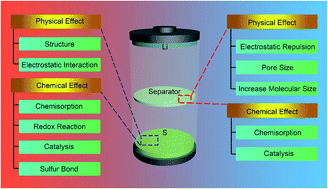Inhibition of polysulfide diffusion in lithium–sulfur batteries: mechanism and improvement strategies
Abstract
Lithium–sulfur batteries present an attractive energy storage option because of their high energy density. However, the shuttle effect leads to a series of problems that hinder their commercialization. The shuttling effect is caused by the dissolution, diffusion, and side reactions of polysulfides, which can be suppressed by inhibiting the diffusion of polysulfides. Thus, many methods have been developed to impede the diffusion of polysulfides, thereby improving the cycle stability and capacity of lithium–sulfur batteries. Throughout the dissolution and diffusion processes of polysulfides, the sulfur electrode and the separator are two key locations to influence the diffusion of polysulfides. At each position, the methods of limiting polysulfide diffusion can be further divided into physical and chemical methods according to the mechanism of interaction between host materials and polysulfides. This review summarizes various methods of limiting the diffusion of polysulfides and discusses their mechanisms of action in depth, which can help to understand the advantages and disadvantages of each method. Finally, based on the recent development of lithium–sulfur batteries, the future prospects of methods for limiting the diffusion of polysulfides have been proposed.

- This article is part of the themed collection: Recent Review Articles


 Please wait while we load your content...
Please wait while we load your content...